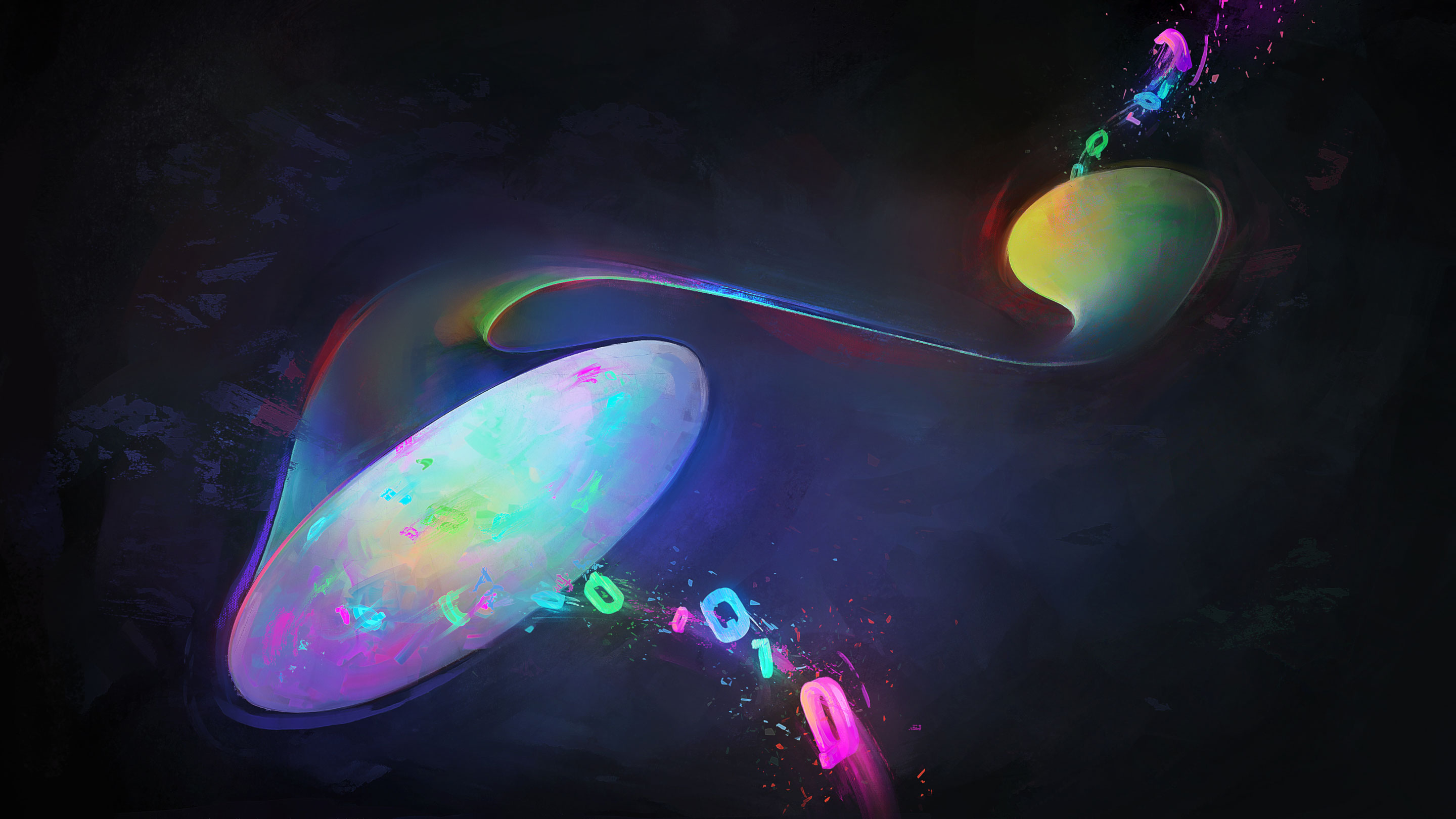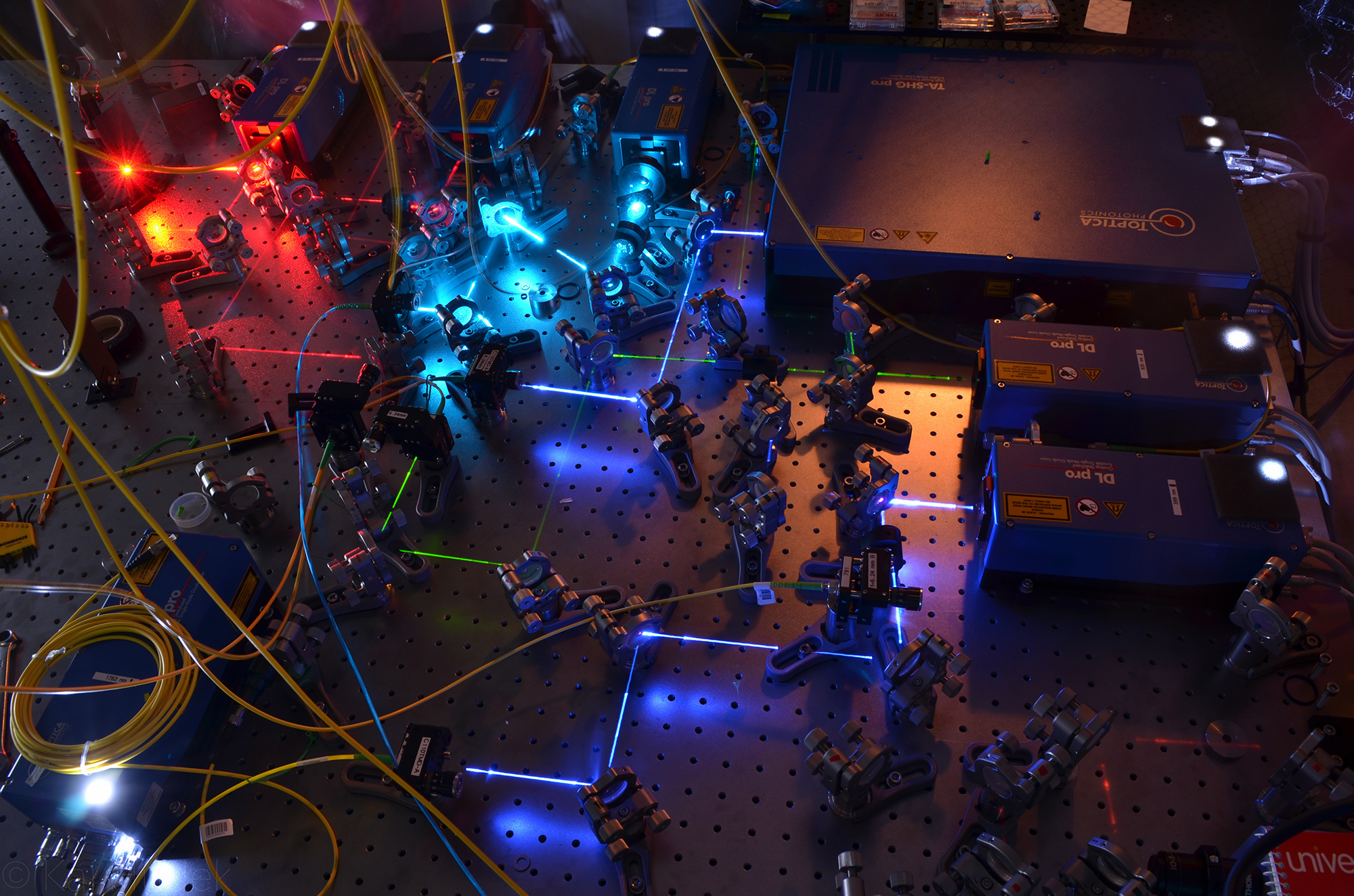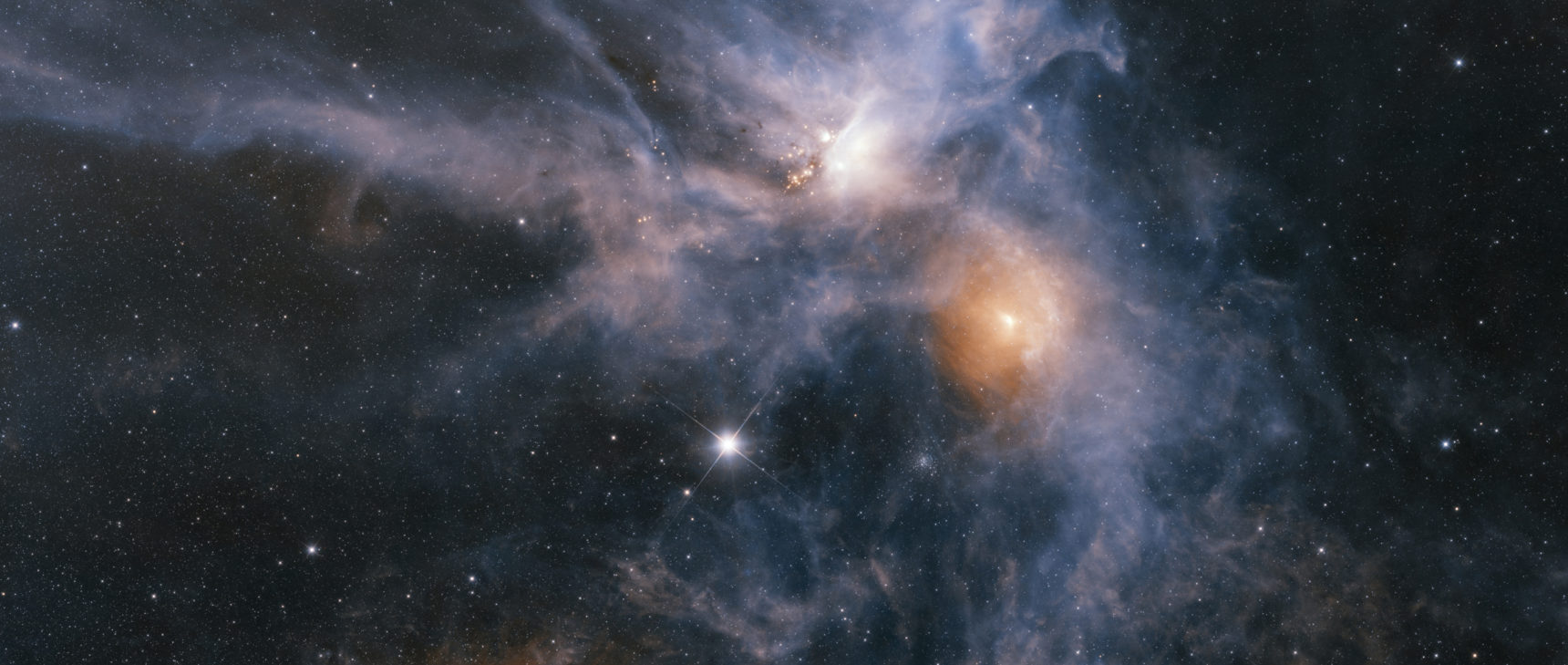Wormholes Reveal a Way to Manipulate Black Hole Information in the Lab

Wormholes offer a way for information to escape the seemingly insurmountable grip of black holes.
Olena Shmahalo/Quanta Magazine
Introduction
As experimental proposals go, this one certainly doesn’t lack ambition. First, take a black hole. Now make a second black hole that is quantum entangled with it, which means that anything that happens to one of the black holes will seem to have an effect on the other, regardless of how far apart they are.
The rest sounds a bit easier, but a lot weirder. Feed some information into the first black hole, encoded in a quantum particle. As it falls beyond the event horizon — the point beyond which not even light can escape — the information is rapidly smeared throughout the black hole and is scrambled seemingly beyond recall.
But have patience — if you’ve linked the two black holes in the right way, after a short wait the quantum information will pop out of the second one, fully refocused into readable form. To get there, it will have traveled through a shortcut in space-time that links the two objects — a wormhole.
That, at least, is what physicists have predicted. Now a group led by Sepehr Nezami of the California Institute of Technology has suggested how to actually perform this extraordinary experiment — and they are beginning to work with collaborators to put the idea to the test.
If the predictions are borne out, the work may offer clues about where to look for the most elusive theory in physics: one that unites quantum mechanics with the theory of general relativity that describes gravity. And, for good measure, it would support the idea that space-time is not the fundamental backdrop against which the universe plays out but is itself woven from the interconnections between particles described by quantum entanglement.
The Death and Resurrection of Information
This experiment, as you might have guessed, doesn’t require black holes in the usual sense, meaning massive stars that have collapsed by their own gravity to an infinitesimally small volume. The researchers say that it could be done on a lab benchtop using just a few atoms or ions. All the same, the idea arises out of theoretical research on astrophysical black holes that has struggled to resolve a deep and unsettling question: Do these all-devouring monsters destroy information irreversibly?
It’s widely thought that information, like energy, should obey a conservation rule: The total amount of information in the universe will always stay the same. That’s what quantum mechanics seems to imply: The wave functions that describe quantum entities always evolve smoothly in an information-conserving way and can’t be suddenly snuffed out.
But black holes do seem to remove information from the universe. If, say, a quantum bit, or “qubit,” falls into a black hole, it can no longer be observed from outside the event horizon.
One possible resolution of this “black hole information paradox” can be found within the radiation that black holes emit from their event horizons. Hawking radiation, predicted by Stephen Hawking in the 1970s, will cause a black hole to lose gravitational energy — and thus mass. In effect, black holes are not eternal. They slowly evaporate.
Hawking initially believed that even if a black hole fully evaporated, the information it had consumed would remain lost forever. But an idea known as the AdS/CFT correspondence shows how the photons of Hawking radiation might be able to encode information about the interior of the black hole, thereby carrying that information back out into the universe at large.
The AdS/CFT correspondence was postulated by the theoretical physicist Juan Maldacena in 1997, and it’s widely regarded as one of the most promising directions in which to pursue theories of quantum gravity. It suggests that the physical structure of space-time in, say, four dimensions is equivalent to the operation of a quantum theory at a three-dimensional boundary.
This connection is strange, deep and surprising. It says that if you construct a space-time with a particular kind of curvature (and thus gravity) known as an anti-de Sitter space — that’s the AdS part — the mathematical description turns out to be equivalent to the description of a kind of quantum field theory called a conformal field theory — that’s the CFT part — in one fewer dimension. In other words, the correspondence works like a hologram — all the information in the higher-dimensional space-time projection is encoded within the lower-dimensional quantum interactions. This “holographic principle” was first proposed by the physics Nobel laureate Gerard ’t Hooft, and Maldacena’s AdS/CFT correspondence provided the first concrete picture of how it might work for a particular form of space-time.
In this view, what looks like continuous space in the AdS universe manifests in the CFT quantum view as entanglement — the interdependence of quantum bits. Here, said Maldacena, “the emergence of space-time is supposed to happen in systems with a large number of qubits that are highly entangled and highly interacting.” In other words, quantum entanglement can produce a space-time that seems to have gravity in it. Gravity, you might say, is spun from quantum effects.
Rapid Scramblers
What does all this have to do with black holes? The black hole information paradox asks what happens to the information that gets tossed into a black hole. The AdS/CFT correspondence is a key component of one proposed solution, since it supplies the means by which quantum entanglement could imprint the information on Hawking radiation and prevent it from being irrevocably lost.
In 2004, Hawking himself explained how, assuming the AdS/CFT conjecture is true, we could recover this information by capturing every single Hawking photon a black hole radiates over its entire lifetime before fully evaporating. As Norman Yao of the University of California, Berkeley described it, “If you were God and you collected all these Hawking photons, there is in principle some ungodly calculation you can do to re-extract the information in [each swallowed] qubit.”
Up until the halfway point of a black hole’s evaporation, the information inside it remains concealed. After that point, however, the black hole starts to reveal its information in its Hawking radiation. So you have a long wait before you can start to get at it. And according to an argument made in 1993 by the physicist Don Page of the University of Alberta, it will then seep out gradually, at a constant rate.
But in 2007, Patrick Hayden and John Preskill revised this picture by showing that, in fact, after the halfway point the information emerges more rapidly than that. Weirdly enough, once the black hole is half-evaporated, any further quantum bit of information tossed into it “literally bounces right back,” said Yao. This is because the black hole has by that stage become so quantum-entangled with the Hawking radiation it has already emitted that any more information it swallows is effectively registered at once in any further radiation it emits. The black hole, Hayden and Preskill said, then acts like an “information mirror.”
Hayden and Preskill had hit on a connection between black hole thermodynamics and quantum information theory that invokes a phenomenon called quantum scrambling. This effect is rather like the way heat gets evenly distributed in a system over time as it comes to equilibrium, a process called thermalization. Imagine, said Yao, creating two systems containing localized pockets of energy and then bringing them into contact. The energy will spread throughout both systems until “they have lost the memory of that initial starting state, and you can no longer distinguish them.”
Scrambling is the same in essence, but much stronger: You can’t distinguish two scrambled systems even if you look not just locally but at correlations across both systems. “Scrambling is a very strong form of thermalization,” said Yao. “It is the delocalization of quantum information.”
“It’s a quantum analogue of shuffling,” said Adam Brown, a physicist at Google and Stanford University. “If you start off with an ordered pack of cards, you say it’s shuffled if you look at the cards and say there is no obvious pattern left in them. This is not the same as saying that you’ve made it entirely random — it’s sufficiently mixed up that you have to be very sophisticated to know that it’s not random. It happens much sooner than genuine randomness.”

Lasers in Christopher Monroe’s lab at the University of Maryland are used to control atom-based quantum bits.
Courtesy of Christopher Monroe group at the University of Maryland
“Almost any many-body quantum system is eventually going to scramble,” he added. But black holes are special. Just as the rate at which a pack of cards gets shuffled depends on the technique you use, the scrambling rate of a system depends on the details of how the particles in that system interact. These details are described mathematically by a function called a Hamiltonian. And it turns out that the Hamiltonian governing black holes means they scramble quantum information at the fastest rate possible.
And that’s what leads to Hayden and Preskill’s conclusion. Black holes act like fast quantum-scrambling circuits, so once they are sufficiently entangled with their own Hawking radiation, any new information entering them shows up very quickly in that radiation.
All the same, you’ll have to wait until the black hole and its Hawking radiation are entangled enough — that is, until it is half evaporated — before this happens.
But there’s a faster alternative for getting at the information: Entangle the black hole maximally with something else — like another black hole. That’s the proposal put forward in 2016 by Ping Gao and Daniel Jafferis of Harvard University, working with Aron Wall at the Institute for Advanced Study in Princeton, New Jersey. If you could entangle a pair of black holes this way, they said, then a qubit swallowed by the first black hole would be registered in the other. Gao and colleagues showed how, by adding a further coupling between the black holes, you could make the transfer of quantum information between them formally identical to the process called quantum teleportation. Here the entanglement between two particles is used to transfer the quantum state of one of them to the other. The target particle ends up looking identical to the initial one — in fact, there is no meaningful way to say it is not the same particle, vanished from one part of space and reconstituted in another. “Their entanglement acts like a bridge” for the information, said Yao.
Systems with the dynamics of black holes, Yao explained, “allow teleportation on the fastest possible timescale.” That’s because any information that enters one of them is quickly shared among all its particles — and thus, because of the entanglement with the second black hole, it’s shared quickly with that one too.
Quantum teleportation has been demonstrated experimentally many times, and it is already being used to send securely encrypted information between quantum devices. It does not, however, allow you to send messages instantly, because the signal can’t be decoded — it looks random — without additional information sent by some classical mechanism, which means it can’t travel faster than light. This, explained Nezami, a former doctoral student of Hayden’s, is why a scheme like the one proposed by Gao and colleagues requires some additional means, beyond entanglement, of coupling the black holes. “The role of the coupling is to send the essential classical data, which, with the aid of entanglement, teleports the signal from one black hole to another,” he said.
This, at least, is how a quantum information theorist would view the process. But according to the AdS/CFT correspondence, the channel between the black holes created by entanglement is equivalent, in a description based on general relativity, to a wormhole in space-time that connects them. In this view, qubits enter one black hole and travel down the wormhole to the other.
Normally, such wormholes — while permitted by general relativity — have been thought to be non-traversable: You couldn’t actually send anything down them. But Gao, Jafferis and Wall showed how quantum information theory and teleportation could be used (within the AdS/CFT picture) to make a wormhole that is traversable.
Experimental Wormholes
If the AdS/CFT correspondence is real, it allows a radical change in perspective. In principle, researchers could construct systems entirely equivalent to wormhole-connected black holes by entangling quantum circuits in the right way and teleporting qubits between them.
Nezami and Brown, working with Leonard Susskind of Stanford, Brian Swingle of the University of Maryland, College Park, and others have now come up with a practical proposal for how to do that. What you need to make a group of quantum particles act like a black hole in this context, they say, is to assign their interactions a Hamiltonian that makes them very rapid scramblers.
Quantum scrambling was in fact only demonstrated unambiguously for the first time last year. Adopting an experimental proposal by Yao and his colleague Beni Yoshida, Christopher Monroe at Maryland and his colleagues created a quantum circuit made from electrically trapped ions whose quantum states had been entangled. In real systems like this, scrambling can be hard to spot among other unruly processes such as classical noise and — in particular — quantum decoherence. Like scrambling, decoherence arises from the interaction and consequent entanglement of particles — but in this case, they are particles in the environment surrounding the quantum system itself. As decoherence proceeds, the information leaks into the environment and is essentially lost for good. Decoherence is impossible to avoid entirely, which makes it the bugbear of quantum computers: Any quantum calculation has to be completed before decoherence randomizes the information.

Individual atoms in Monroe’s lab are held in place by electrodes. Laser light causes the atoms to fluoresce.
Courtesy of Christopher Monroe group at the University of Maryland
Usually, decoherence tends to happen faster than scrambling, so it has been very hard to see the latter clearly. Monroe’s team figured out how to distinguish the two using a quantum teleportation algorithm encoded in a circuit made from seven coupled ytterbium ions held in a row, each acting as a single qubit. The process — a quantum computation, in effect — teleported a single qubit from one end of the row to the other. To measure the rate of scrambling, the researchers compared the teleportation process as the algorithm evolved forward and then in reverse (as if it were happening “backward in time”). Without scrambling, the two processes remain correlated. But as scrambling disperses the information initially encoded in certain qubits among the others, the outcomes of the forward and backward computations become less correlated: The system has changed from its initial state, and so the teleportation can’t be precisely reversed. “If they’re correlated, not much is happening,” said Monroe. “But if there’s scrambling, the correlation goes to zero.” That’s what they saw as time progressed.
Brown and colleagues now suggest that quantum circuits very much like these could be used to construct a simple analogue of the situation envisioned by Gao, Jafferis and Wall for a traversable wormhole that could teleport a qubit. In the version they imagine, each of the two black holes is made up of just a few qubits, all of which are maximally entangled with one another. Their protocol introduces a further interaction between these two groups of qubits, which acts as the additional channel needed by Gao and colleagues to complete the teleportation process.
Intuition tells us that a handful of ions in an electromagnetic trap is nothing like a collapsed star from which no light can escape. But here’s the mind-bending thing: If the AdS/CFT correspondence is right, then these experiments would be more than a laboratory analogue of a black hole. The two types of systems would be entirely equivalent. The coupled ions are precisely what, in an AdS space, a (very tiny) black hole would look like. It’s an illustration of how, if Maldacena’s conjecture tells us something real about the way the universe is constituted, our intuitions about what things are would be shattered.
New Connections
In a chat with his Maryland colleague Monroe last October, Swingle described his wormhole-like quantum circuit. Monroe recognized that it was more or less precisely the kind of circuit his team had used to demonstrate quantum scrambling. Although Monroe had been aware of Hayden and Preskill’s ideas on using quantum entanglement to recover quantum information from a black hole, he said that his team had chosen their circuit simply to demonstrate quantum scrambling, without really thinking about the connection to gravity.
If the circuit devised by Swingle and colleagues can indeed be built, it should be rather straightforward to look for the effect they predict. Can that be done? “Absolutely,” said Monroe. What one would expect to see is that, first, a quantum bit of information fed into one of the two black-hole-type qubit systems would be scrambled and appear to vanish. But after a predictable amount of time, it would pop out again, unscrambled, in the other group of qubits, having jumped down the wormhole. The surprise is not so much that the information is transferred — the two systems are coupled, after all. It’s that the information reappears in a readable form, needing no decoding, even though the first “black hole” fully scrambled it.
At this stage, experiments using quantum circuits can hope to create only a simplified toy model of the space-time we inhabit, described by general relativity. “If the goal is to get a space-time governed by Einstein’s equations,” said Maldacena, “then the only systems that are known to produce it are very special and probably hard to make in the lab.” But he adds that “the goal of these authors is to create a system complex enough to have some features of gravity (though not all), but simple enough that it could actually be done.”
If the results of such an experiment bear out the predictions, will the AdS/CFT correspondence be proved correct? That depends on your point of view. There is nothing in the theoretical analysis of these quantum circuits that isn’t fully consistent with standard quantum theory. But it is simpler and more economical to describe what is going on in the language of gravity: as a passage along a wormhole. “While you could explain it all by using the Schrödinger equation, there’s a much simpler explanation that invokes black holes,” said Brown.
And isn’t it the goal of physics, asks Swingle, to look for such economy, and to ascribe a meaningful reality to that description? You could, for example, describe superconductivity — another quantum phenomenon — purely in terms of electron wave functions. But it’s much simpler to use a “quasiparticle” picture: to consider the so-called Cooper pairs of entangled electrons. We don’t question the reality of these quasiparticles — and so why should we deny the reality of qubit wormholes?
For this reason, said Monroe, “from observations of atoms, we might learn about something that has nothing to do with atoms” — namely, black holes. And more ambitious versions of the experiment using many-qubit systems could reveal interesting properties of space-time itself. “If these experiments can be done, it might become possible to create more and more complex entangled systems that could test more aspects of the emergence of space-time from quantum systems,” said Maldacena. Added Nezami: “A sophisticated experiment of this type could even provide an experimental probe of the mathematics of string theory.”
As to the prospects for such an experiment, Swingle said that he is talking to various experimentalists about adapting quantum-scrambling circuits into a direct test of these far-out ideas, although concrete plans have yet to emerge. But the conversations themselves are something of a milestone. “Here we have theoretical physicists from quantum gravity talking to experimental atomic physicists,” said Brown. “Historically they have been about as far apart as any two groups in a physics department. So this is a new thing, and it’s great.”
This article was reprinted on TheAtlantic.com.




